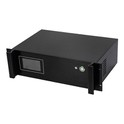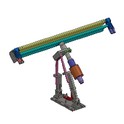Hey there! As a supplier of 1000w ultrasonic generators, I often get asked if our 1000w ultrasonic generator can be used for ultrasonic embossing. Well, let's dive right into it and find out!
First off, let's understand what ultrasonic embossing is. Ultrasonic embossing is a process that uses high - frequency ultrasonic vibrations to create patterns or designs on materials like plastics, textiles, and leather. The ultrasonic energy is transferred to the material through a sonotrode (also known as a horn), which causes the molecules in the material to vibrate rapidly. This vibration generates heat, which softens the material and allows it to take on the shape of the embossing die.
Now, let's talk about our 1000w ultrasonic generator. A 1000w ultrasonic generator is a pretty powerful piece of equipment. It can produce a significant amount of ultrasonic energy, which is a good start for ultrasonic embossing. The power output of the generator is crucial because it determines how much energy can be transferred to the material. With 1000w of power, it has the potential to handle a variety of embossing tasks.
However, whether it can be used for ultrasonic embossing depends on several factors.
Material Type
Different materials have different requirements when it comes to ultrasonic embossing. For example, thin and soft plastics may require less energy for embossing compared to thick and dense leather. A 1000w ultrasonic generator can work well with many common plastics and thin textiles. These materials can absorb and transform the ultrasonic energy into heat relatively easily, allowing for a smooth embossing process.
But if you're dealing with very thick or highly heat - resistant materials, the 1000w might not be enough. In such cases, you might need a more powerful generator, like the 2000W Ultrasonic Generator or even the 6000W Ultrasonic Generator.
Embossing Complexity
The complexity of the embossing pattern also matters. Simple patterns with large areas and shallow depths can usually be achieved with a 1000w generator. The generator can evenly distribute the energy across the material to create the desired shape. But for intricate patterns with fine details and deep embossing, more energy might be required. The ultrasonic waves need to penetrate deeper into the material and create precise shapes, which can be challenging with just 1000w.
Production Speed
If you're looking for high - speed production, a 1000w generator might have its limitations. Higher production speeds mean that the material needs to be embossed quickly, which requires more energy to be transferred in a shorter period. In a high - volume production environment, you may find that a 1000w generator can't keep up, and you might consider upgrading to a more powerful option.
On the flip side, for small - scale production or prototyping, a 1000w ultrasonic generator can be a great choice. It's more cost - effective and can still produce good - quality embossing results.
Compatibility with Other Components
The ultrasonic generator needs to work in harmony with other components in the embossing system, such as the sonotrode and the booster. The sonotrode is responsible for transferring the ultrasonic energy from the generator to the material. If the sonotrode is not properly designed or matched with the 1000w generator, it can lead to inefficient energy transfer and poor embossing quality.
Similarly, the booster amplifies the ultrasonic vibrations. An inappropriate booster can also affect the performance of the embossing system. So, it's essential to ensure that all the components are well - matched and calibrated.
Advantages of Using a 1000w Ultrasonic Generator for Embossing
Despite the potential limitations, there are several advantages of using a 1000w ultrasonic generator for ultrasonic embossing.
- Cost - Efficiency: A 1000w generator is generally more affordable than higher - power models. If your embossing needs are not extremely demanding, investing in a 1000w generator can save you a significant amount of money.
- Energy Saving: Compared to more powerful generators, a 1000w generator consumes less electricity. This can lead to long - term cost savings, especially if you're running the embossing process for extended periods.
- Compact Size: 1000w generators are usually more compact and easier to install. They take up less space in your workshop, which is a big plus if you have limited space.
Other Options
If you're not sure whether a 1000w generator is right for your ultrasonic embossing needs, we also offer a 500W Ultrasonic Generator. This lower - power option can be suitable for very small - scale or low - energy embossing tasks, such as embossing thin labels or small plastic parts.
In conclusion, a 1000w ultrasonic generator can be used for ultrasonic embossing, but it depends on various factors like material type, embossing complexity, production speed, and component compatibility. If you're in the market for an ultrasonic generator for embossing, it's important to carefully evaluate your specific requirements.
If you have any questions about our 1000w ultrasonic generator or any of our other products, don't hesitate to reach out. We're here to help you find the best solution for your ultrasonic embossing needs. Let's have a chat and see how we can work together to achieve great embossing results!


References
- Ultrasonic Welding and Embossing Handbook
- Journal of Ultrasonic Applications in Material Processing





